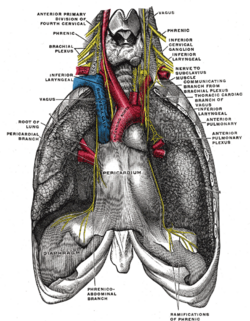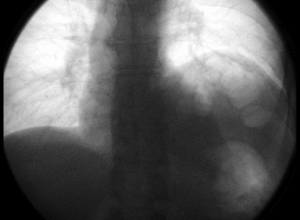Phrenic nerve facts for kids
Quick facts for kids Phrenic nerve |
|
|---|---|
 |
|
| The phrenic nerve as it passes through the thorax to supply the diaphragm. | |
 |
|
| The phrenic nerve emerges from the cervical plexus, with the right brachial plexus shown here. | |
| Latin | nervus phrenicus |
The phrenic nerve is a very important nerve in your body. It starts in your neck, from spinal nerves C3 to C5. This nerve is super important for breathing. It controls your diaphragm, which is the main muscle you use to breathe.
In people, the right and left phrenic nerves mostly get signals from the C4 spinal nerve. But they also get some help from the C3 and C5 spinal nerves. From your neck, this nerve travels down into your chest. It passes between your heart and lungs to reach your diaphragm.
The phrenic nerve has different kinds of fibers. It has motor fibers that tell your diaphragm to move. It also has sensory fibers that send information back to your brain. These fibers get input from the middle part of your diaphragm and the lining around your lungs. The word "phrenic" comes from an Ancient Greek word, phren, which means 'diaphragm'.
How the Phrenic Nerve is Built
The phrenic nerve starts deep inside your spinal cord in the neck area. It then travels downwards. It goes past some important blood vessels and muscles in your neck.
- The right phrenic nerve goes over a large artery called the brachiocephalic artery. It then crosses in front of the root of your right lung. Finally, it leaves your thorax (chest) by going through an opening in the diaphragm. This opening is for a large vein called the vena cava. The right phrenic nerve also passes over the right side of your heart.
- The left phrenic nerve goes over the covering of the left ventricle, which is a part of your heart. It then goes through the diaphragm on its own.
Small arteries and veins, called pericardiacophrenic vessels, travel right alongside these phrenic nerves.
Why the Phrenic Nerve is Important for Your Health
Sometimes, if there's a problem with the phrenic nerve, you might feel pain in a different part of your body. This is called "referred pain." For example, if there's an issue under your right diaphragm, you might feel pain in your right shoulder. This happens because the nerves in those areas are connected.
If the phrenic nerve or the tissues it supplies get irritated, it can cause hiccups. A hiccup is when your diaphragm suddenly contracts. This pulls air into your lungs while your voice box (larynx) closes, making that "hic" sound.
Doctors need to be very careful with the phrenic nerve during chest surgery. They must identify it and protect it. To make sure they've found the right nerve, a doctor might gently touch it. This can cause the diaphragm to twitch, confirming it's the phrenic nerve.
If the phrenic nerve is damaged, that half of your diaphragm can become paralyzed. If both phrenic nerves are damaged, it can make breathing very hard. This can happen because of spinal cord injuries, certain diseases, or even after heart or lung surgery. Doctors can often see diaphragm paralysis using a special scan called sonography. Even if one side of your diaphragm is paralyzed, you can usually still breathe, as long as the other side is working.
Since the phrenic nerve starts in your neck (C3-C5) but controls your diaphragm much lower down, people with spinal cord injuries below the neck can often still breathe well. This is true even if their legs are paralyzed.


